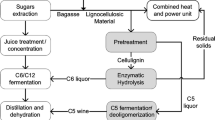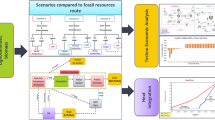Abstract
In value-added chemical industries, use of agricultural wastes as raw materials remains to be a major challenge in commercialization due to lack of competitiveness with respect to petrochemical processes. This work presents the techno-economic analysis of a novel bioprocessing plant converting 356,400 MT/year cotton stalks into 147,000 MT/year acetic acid. A production scheme integrating lignin separation with the main bioconversion stages has been proposed. Techno-economic assessment was performed through economic feasibility and retro-techno-economic analysis (RTEA) methods. The RTEA method has been extended to include the estimation of research and development funding for improving economic feasibility. Carbon offset of the proposed technology has been estimated and carbon credit results have been incorporated into the economic feasibility metrics.




Similar content being viewed by others
References
Bento AM, Kanbur R, Leard B (2015) Designing efficient markets for carbon offsets with distributional constraints. J Environ Econ Manag 70:51–71
Wang Z, Wang C (2015) How carbon offsetting scheme impacts the duopoly output in production and abatement: analysis in the context of carbon cap-and-trade. J Clean Prod 103:715–723
USDA United States Department of Agriculture, Foreign Agricultural Service (2016) Turkey: cotton and products. http://www.fas.usda.gov/data/turkey-cotton-and-products-annual-0. Accessed 18 May 2017
TCGTB T.C. Gümrük ve Ticaret Bakanlığı (2015) Pamuk Raporu. http://koop.gtb.gov.tr/ara/?q=pamuk. Accessed 18 May 2017
Akdeniz RC, Acaroglu M, Hepbasli A (2004) Cotton stalk as a potential energy source. Energy Sources 26:65–75
Huang H, Bai Z, Hoefel D, Qing Hu Q, Lv X, Zhuang G, Xu S, Qi H, Zhang H (2012) Effects of cotton straw amendment on soil fertility and microbial communities. Front Environ Sci Eng 6(3):336–349. https://doi.org/10.1007/s11783-011-0337-z
Saeidy E (2004) Renewable energy in agriculture in Egypt technological fundamentals of briquetting cotton stalks as a biofuel. Dissertation. Landwirtschaftlich-Gärtnerischen Fakultät der Humboldt-Universität zu Berlin
Coates W (1996) Harvesting systems for cotton plant residue. Appl Eng Agric 12(6):639–644. https://doi.org/10.13031/2013.25693
Ebner H, Sellmer S, Follman H (1996) Biotechnology: products of primary metabolism, vol 6, 2nd edn. Rehm H-J, Reed G (eds) Wiley, Hoboken. https://doi.org/10.1002/9783527620883.ch12
Business and Wire (2016) Global acetic acid market—segmented by application. http://www.researchandmarkets.com/research/rvx82w/global_acetic. Accessed 18 May 2017
Grand View Research (2015) Acetic acid market analysis by application (VAM, acetic anhydride, acetate esters, PTA) and segment forecasts to 2022. http://www.grandviewresearch.com/industry-analysis/acetic-acid-market/toc. Accessed 18 May 2017
Zion Market Research (2017) https://globenewswire.com/news-release/2017/10/26/1154381/0/en/Global-Acetic-Acid-Market-Size-Demand-to-Surpass-USD-13-65-Billion-by-2021-Zion-Market-Research.html. Accessed 29 Nov 2017
Wang M, Zhou D, Wang Y, Wei S, Yang W, Kuang M, Ma L, Fang D, Xu S, Du S (2016) Bioethanol production from cotton stalk: a comparative stdy of various pretreatments. Fuel 184:527–532
Akpinar O, Levent O, Bostanci Ş, Bakir U, Yilmaz L (2011) The optimization of dilute acid hydrolysis of cotton stalk in xylose production. Appl Biochem Biotechnol 163:313–325
Yuan X, Ma L, Wen B, Zhou D, Kuang M, Yang W, Cui Z (2016) Enhancing anaerobic digestion of cotton stalk by pretreatment with a microbial consortium (MC1). Bioresour Technol 207:293–301
Wonga BT, Show KY, Lee DJ, Lai JY (2009) Carbon balance of anaerobic granulation process: carbon credit. Bioresour Technol 100(5):1734–1739
Green Building Stocks (2007) Meet the carbon market. http://www.greenchipstocks.com. Accessed 30 Dec 2016
Ehsanipour M, Vazjovic-Suko A, Bura R (2016) Fermentation of lignocellulosic sugars to acetic acid by Moorella thermoacetica. J Ind Microbiol Biotechnol 43(6):807–816. https://doi.org/10.1007/S10295-016-1756-4
Davis R, Tao L, Scarlata C, Tan ECD, Ross J, Lukas J, Sexton D (2015) Process design and economics for the conversion of lignocellulosic biomass to hydrocarbons: dilute acid and enzymatic deconstruction of biomass to sugars and biological conversion of sugars to hydrocarbons (no. NREL/TP-5100-62498), technical report. National Renewable Energy Laboratory (NREL), Golden
Davis R, Tao L, Tan ECD, Biddy MJ, Beckham GT, Scarlata C, Jacobson J, Cafferty K, Ross J, Lukas J, Knorr D, Schoen P (2013) Process design and economics for the conversion of lignocellulosic biomass to hydrocarbons: dilute acid and enzymatic deconstruction of biomass to sugars and biological conversion of sugars to hydrocarbons (no. NREL/TP-5100-60223), technical report. National Renewable Energy Laboratory (NREL), Golden
Kazi FK, Fortman J, Anex R, Kothandaraman R, Hsu D, Aden A, Dutta A (2010) Techno-economic analysis of biochemical scenarios for production of cellulosic ethanol (no. NREL/TP-6A2-46588), technical report. National Renewable Energy Laboratory (NREL), Golden
Dussán KJ, Silva DDV, Moraes EJC, Arruda PV, Felipe MGA (2014) Dilute-acid hydrolysis of cellulose to glucose from sugarcane bagasse. Chem Eng Trans 10:433–438. https://doi.org/10.3303/CET1438073
Zhang H, Zhang L, Gong Y, Chen Li C, Zhu C (2010) Liquid–liquid equilibria for the ternary system water (1) + acetic acid (2) + diisopropyl ether (3) at (293.15, 303.15, and 313.15) K. J Chem Eng Data 55(11):5354–5358. https://doi.org/10.1021/je100680r
Woodley JM, Titchener-Hooker JM (1996) The use of windows of operation as a bioprocess design tool. Bioprocess Eng 14:263–268
Furlan FF, Costa BBC, Secchi AR, Woodley JM, Giordano RC (2016) Retro-techno-economic analysis: using (bio) process systems engineering tools to attain process target values. Ind Eng Chem Res 55:9865–9871. https://doi.org/10.1021/acs.jecr.6b01757
Akpinar O, Ak O, Kavas A, Bakır U, Yilmaz L (2007) Enzymatic production of xylooligosaccharides from cotton stalks. J Agric Food Chem 55:5544–5551
Bisaria VS, Kondo A (2014) Bioprocessing of renewable resources to commodity bioproducts. I. Edition. Wiley, Hoboken
Wyman CE, Decker SR, Brady JW, Himmel ME, Viikari L (2005) Hydrolysis of cellulose and hemicellulose. Polysacch Struct Divers Funct Versatility 1:1023–1062. https://doi.org/10.1201/9781420030822.ch43
Ljungdahl LG (1986) The autotrophic pathway of acetate synthesis in acetogenic bacteria. Ann Rev Microbiol 40:415–450
Fournier RL. Edition (2012) Basic transport phenomena in biomedical engineering. III. CRC Press, Taylor-Francis Group, Florida, p 20
Berthold GD (2013) Recombinant factor VIII (Kogenate) for the treatment of hemophilia A: the first and only world–wide licensed recombinant protein produced in high–throughput perfusion culture. In: Jörg Knäblein J (ed) Modern biopharmaceuticals: recent success stories. Wiley, Hoboken
Najafpour G, Younesi H, İsmail KSK (2004) Ethanol fermentation in an immobilized cell reactor using Saccharomyces cerevisiae. Bioresour Technol 92:251–260
Tandon SK, Sundaramoorthy C (2009) Environmental preservation through use of cotton stalks for industrial purpose. In: International workshop on “Utilization of cotton plant by by-produce for value-added products”. https://www.icac.org/projects/CommonFund/20_ucbvp/papers/09_tandon.pdf. Accessed 25 July 2018
Cefic-ECTA (2011) Guidelines for measuring and managing CO2 from freight transport operations. http://www.cefic.org/Documents/IndustrySupport/Transport-and-Logistics/MeasuringAndManagingCO2EmissionOfEuropeanTransport. Accessed 25 July 2018
US Energy Information Administration (2016) http://www.eia.gov/tools/faqs. Accessed 1 Dec 2016
Aube F (2001) Guide for computing CO2 emissions associated with energy use. CADDET Energy Effic Newsl 1:25–27
Winnipeg (2016) Emission factors in kg CO2-equivalent per unit. http://www.winnipeg.ca/search/default.stm?q=Sulfuric+acid&sa=%EF%80%82. Accessed 1 Dec 2016
The International Potash Institute (2011) Optimizing crop nutrition. http://www.ipipotash.org/udocs/ifc_no_29_december_2012_hr.pdf. Accessed 2 Dec 2016
Adom F, Dunn JB (2015) Material and energy flows in the production of macro and micronutrients, buffers, and chemicals used in biochemical processes for the production of fuels and chemicals from biomass. Energy Systems Division, National Argonne Laboratory, USA
Marinussen M, Kool A (2010) Environmental impacts of synthetic amino acid production, technical report. Blonk Milieu Advies BV. Technical Report. http://www.blonkconsultants.nl/wp-content/uploads/2016/06/amino-acids.pdf. Accessed 25 July 2018
California Carbon Dashboard (2016) http://calcarbondash.org/. Accessed 2 Dec 2016
Kossoy A, Peszko G, Oppermann K, Prytz N, Klein N, Blok K, Lam L, Wong L, Borkent B (2015) State and trends of carbon pricing 2015. State and trends of carbon pricing. World Bank Group, Washington, DC
Thomson Reuters (2014) EU carbon price to average €23/t between 2021 and 2030: Thomson Reuters assess the future. http://blog.financial.thomsonreuters.com/eu-carbon-price-average-e23t-2021-2030-thomson-reuters-assess-future/. Accessed 2 Dec 2016
Lama KF, Leungb CCJ, Leic HM, Lin CSK (2014) Economic feasibility of a pilot-scale fermentative succinic acid production from bakery wastes. Food Bioprod Process 92(3):282–290. https://doi.org/10.1016/j.fbp.2013.09.001
Sacramento-Rivero JC, Navarro-Pineda F, Vilchiz-Bravo LE (2016) Evaluating the sustainability of biorefineries at the conceptual design stage. Chem Eng Res Des 107:167–180
Acknowledgements
This work is supported by The Scientific and Technological Research Council of Turkey (TUBITAK) (Grant number 114M486) and Marmara University Scientific Research Committee (FEN-E-130313-0077).
Author information
Authors and Affiliations
Corresponding author
Rights and permissions
About this article
Cite this article
Sayar, N.A., Kazan, D., Pinar, O. et al. Retro-techno-economic evaluation of acetic acid production using cotton stalk as feedstock. J Mater Cycles Waste Manag 20, 2077–2088 (2018). https://doi.org/10.1007/s10163-018-0762-1
Received:
Accepted:
Published:
Issue Date:
DOI: https://doi.org/10.1007/s10163-018-0762-1




